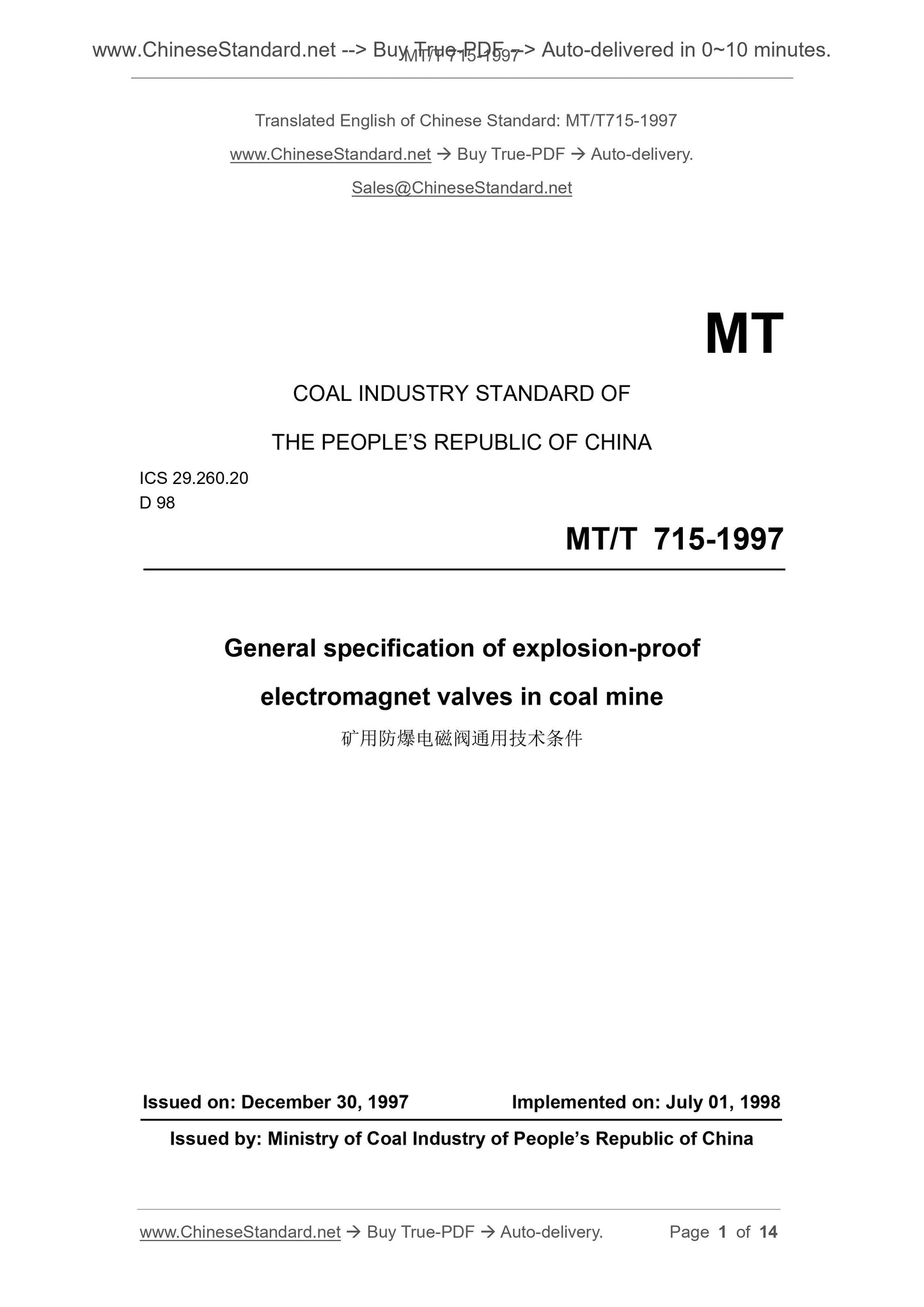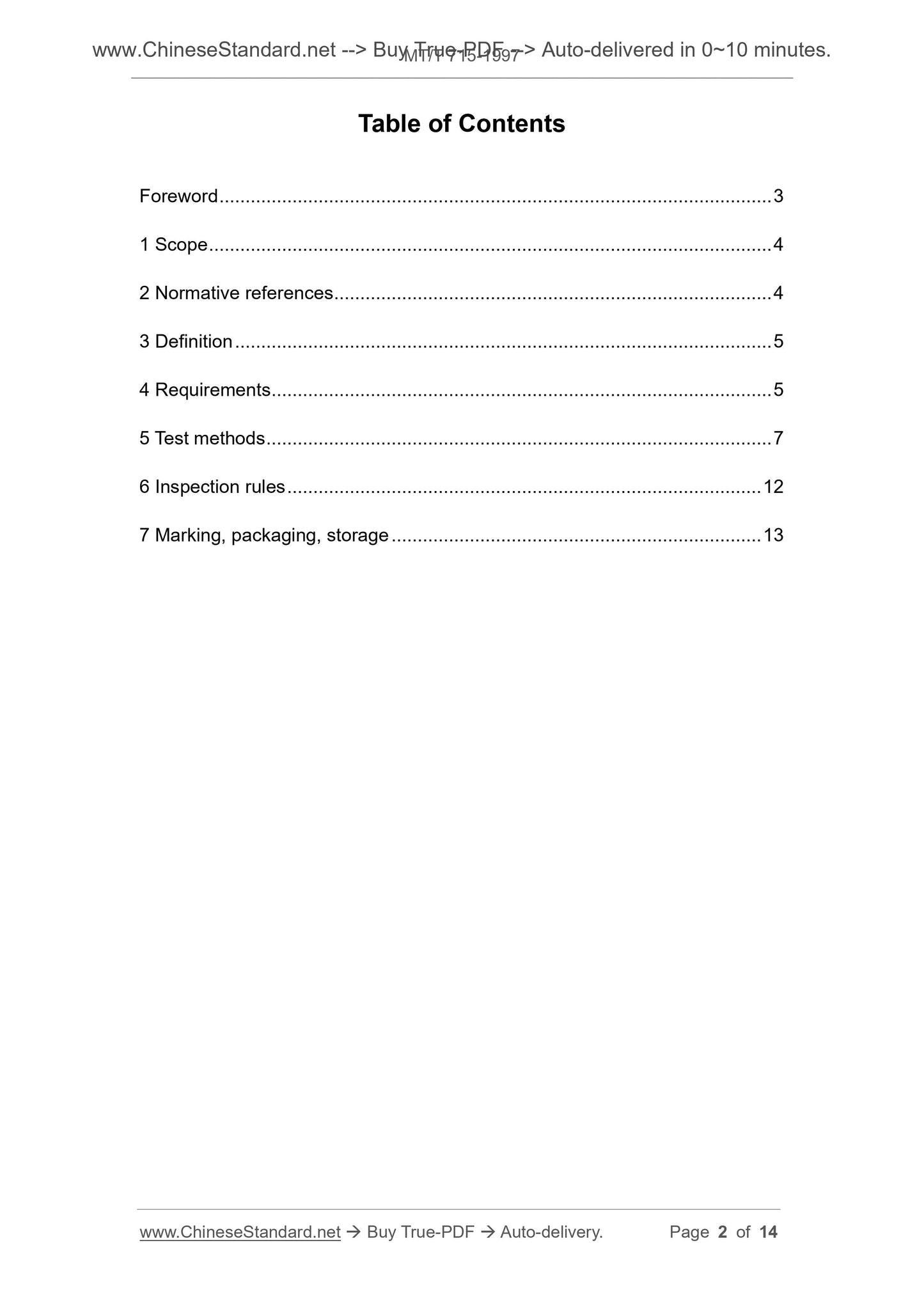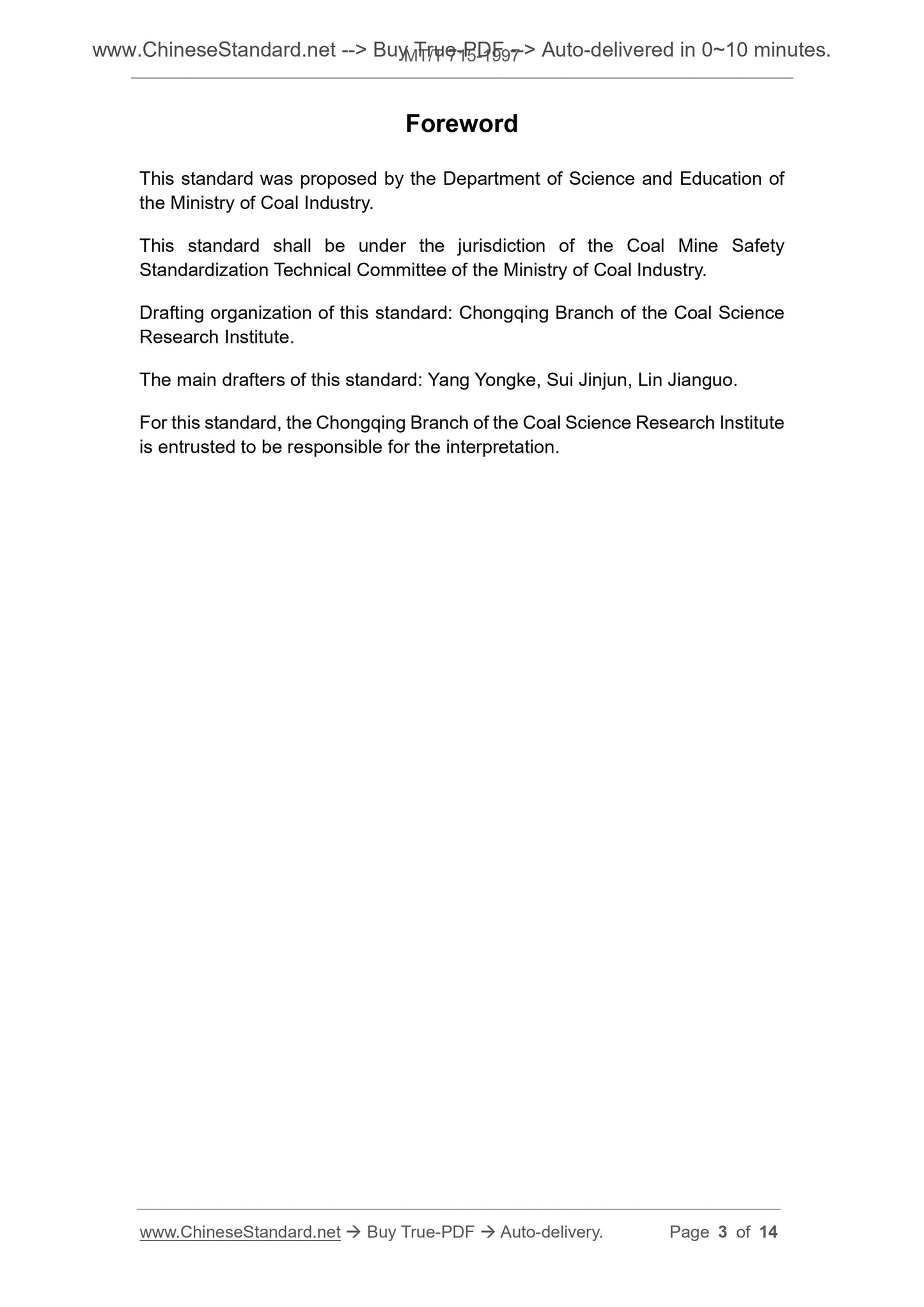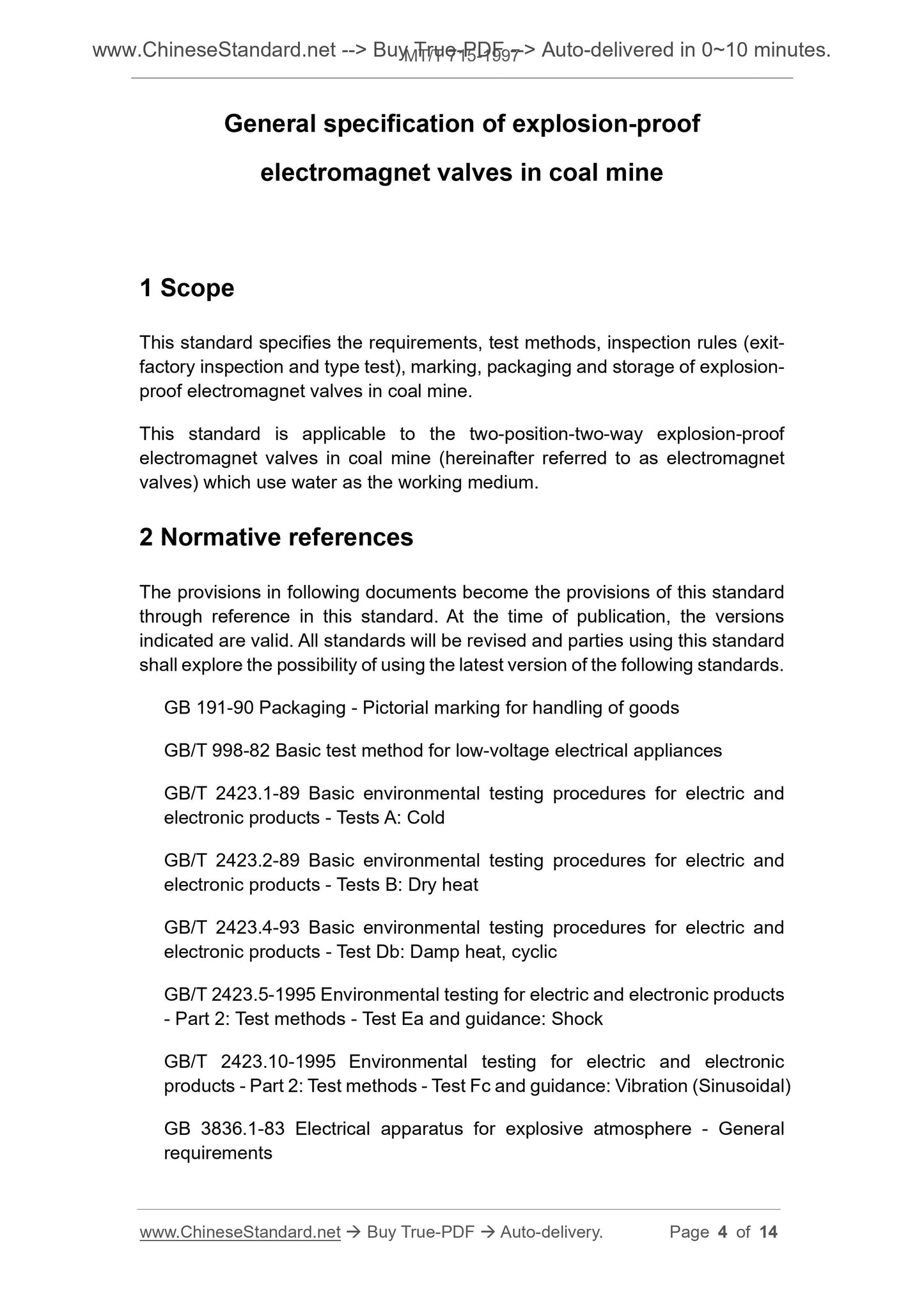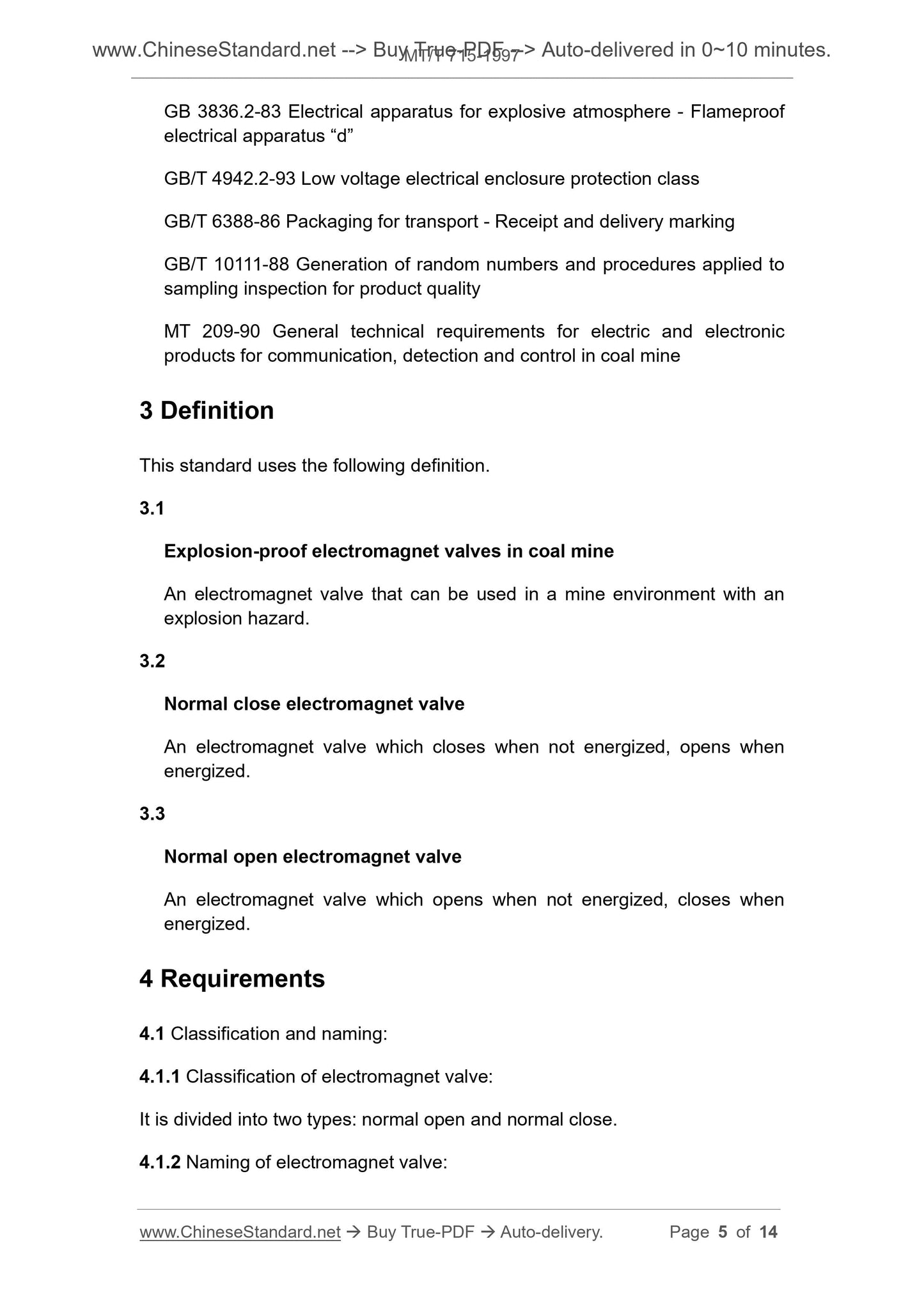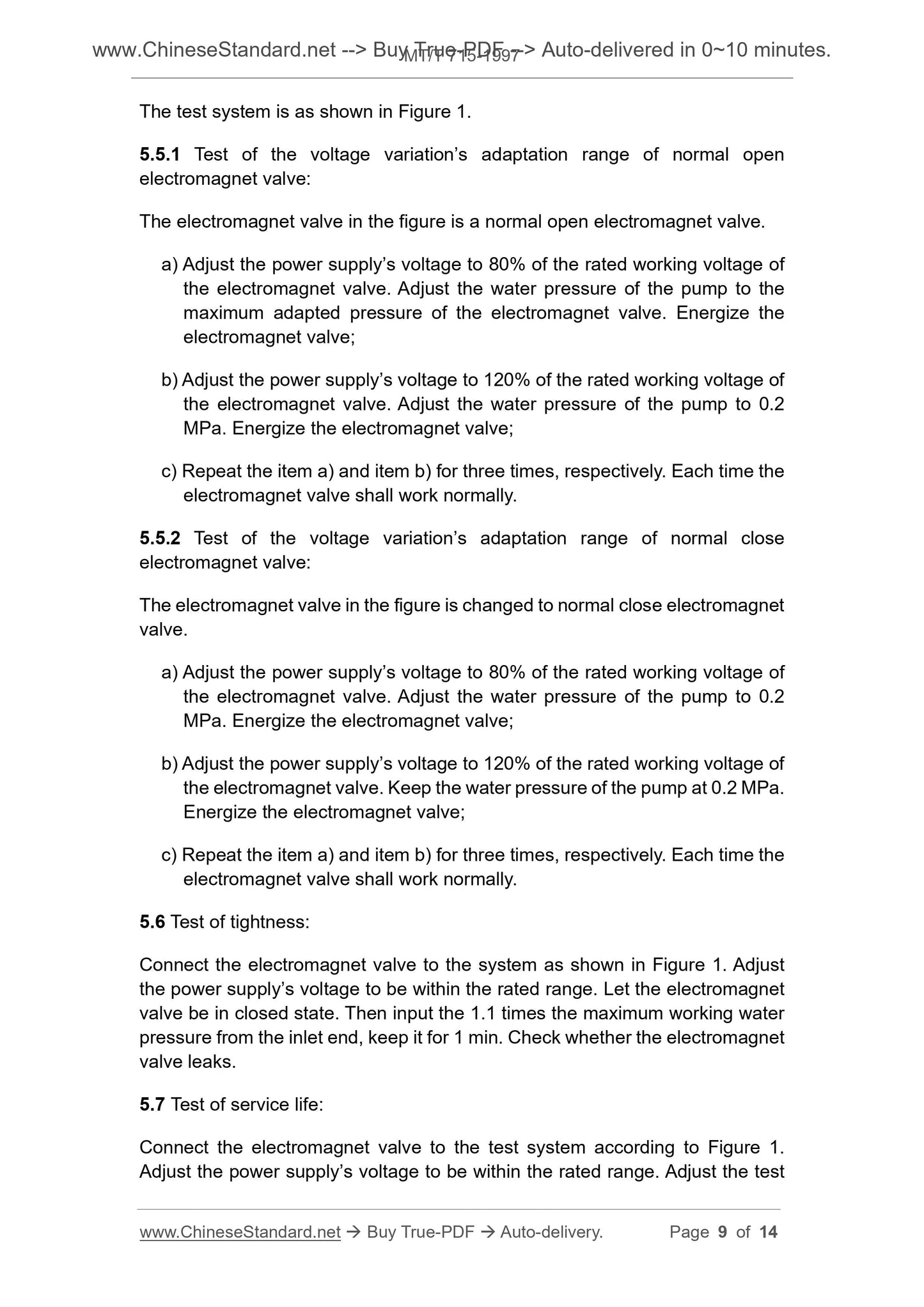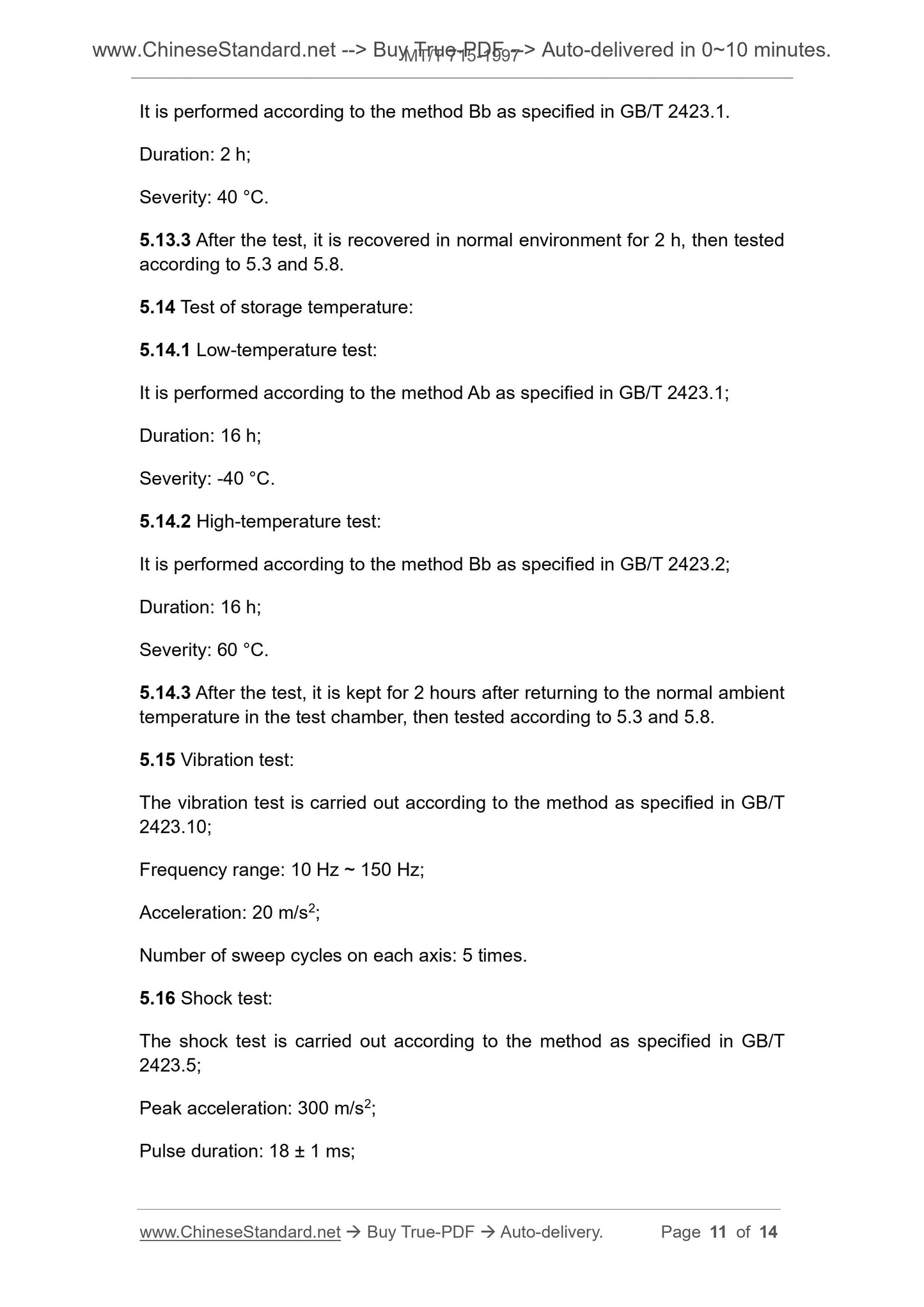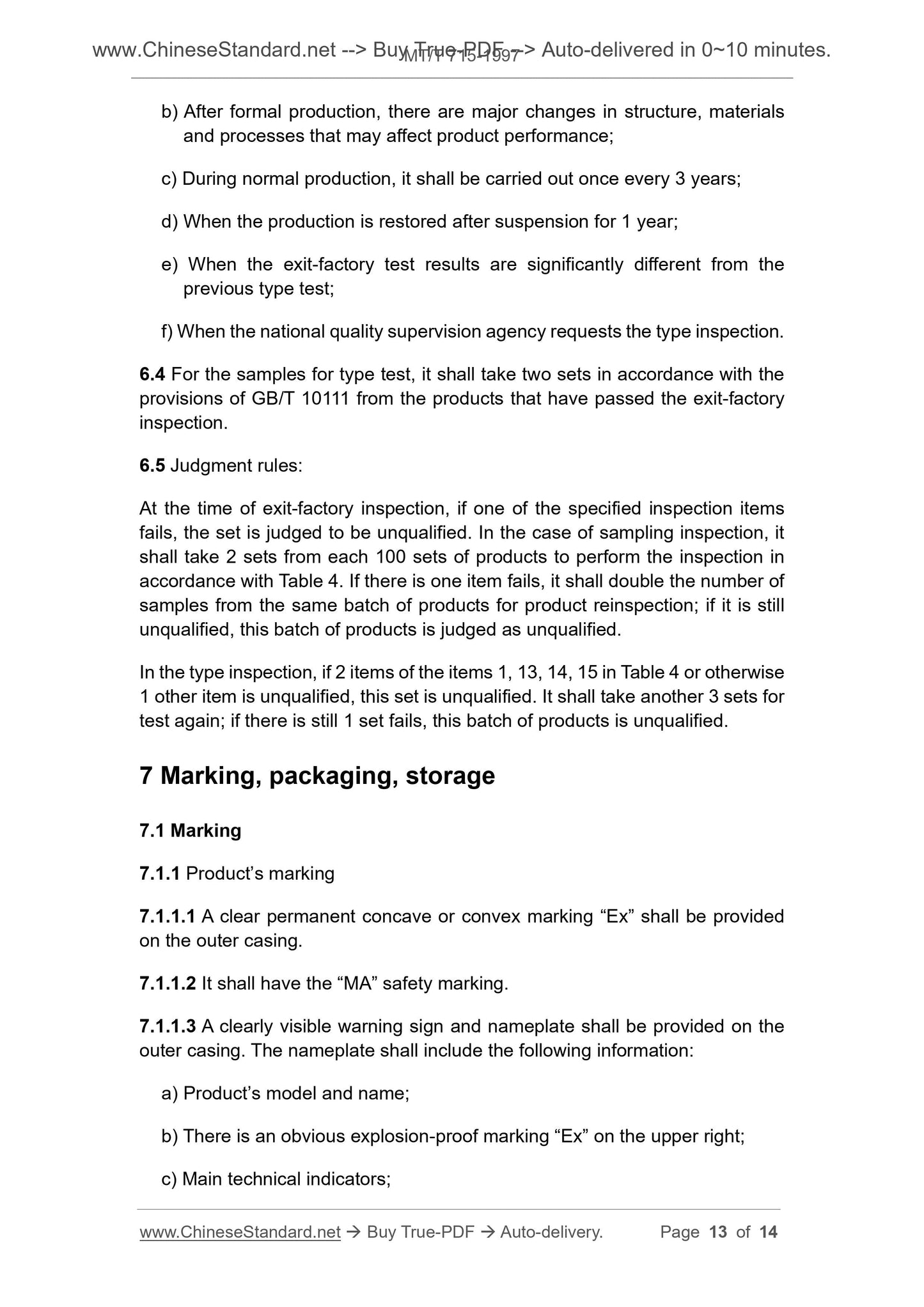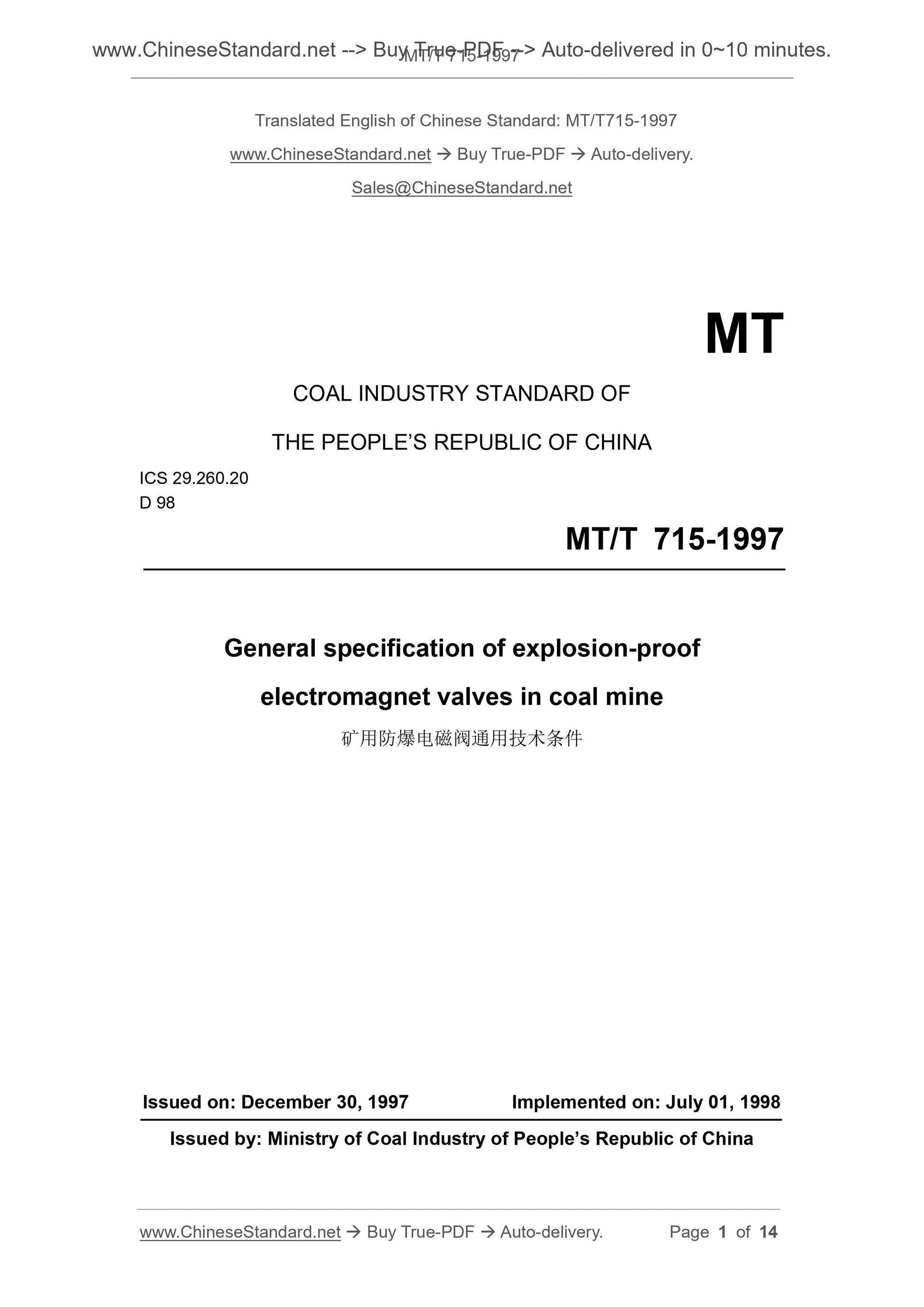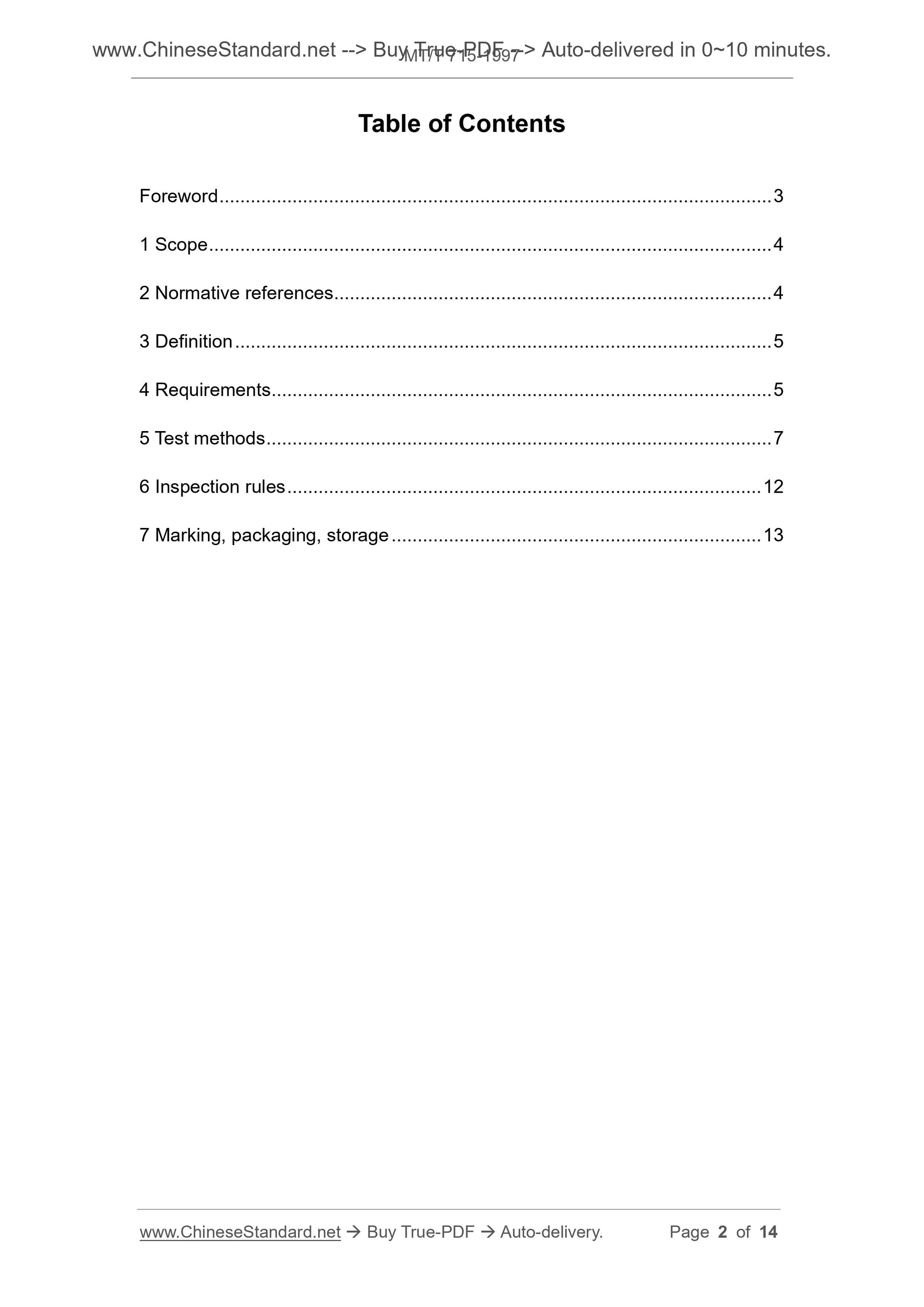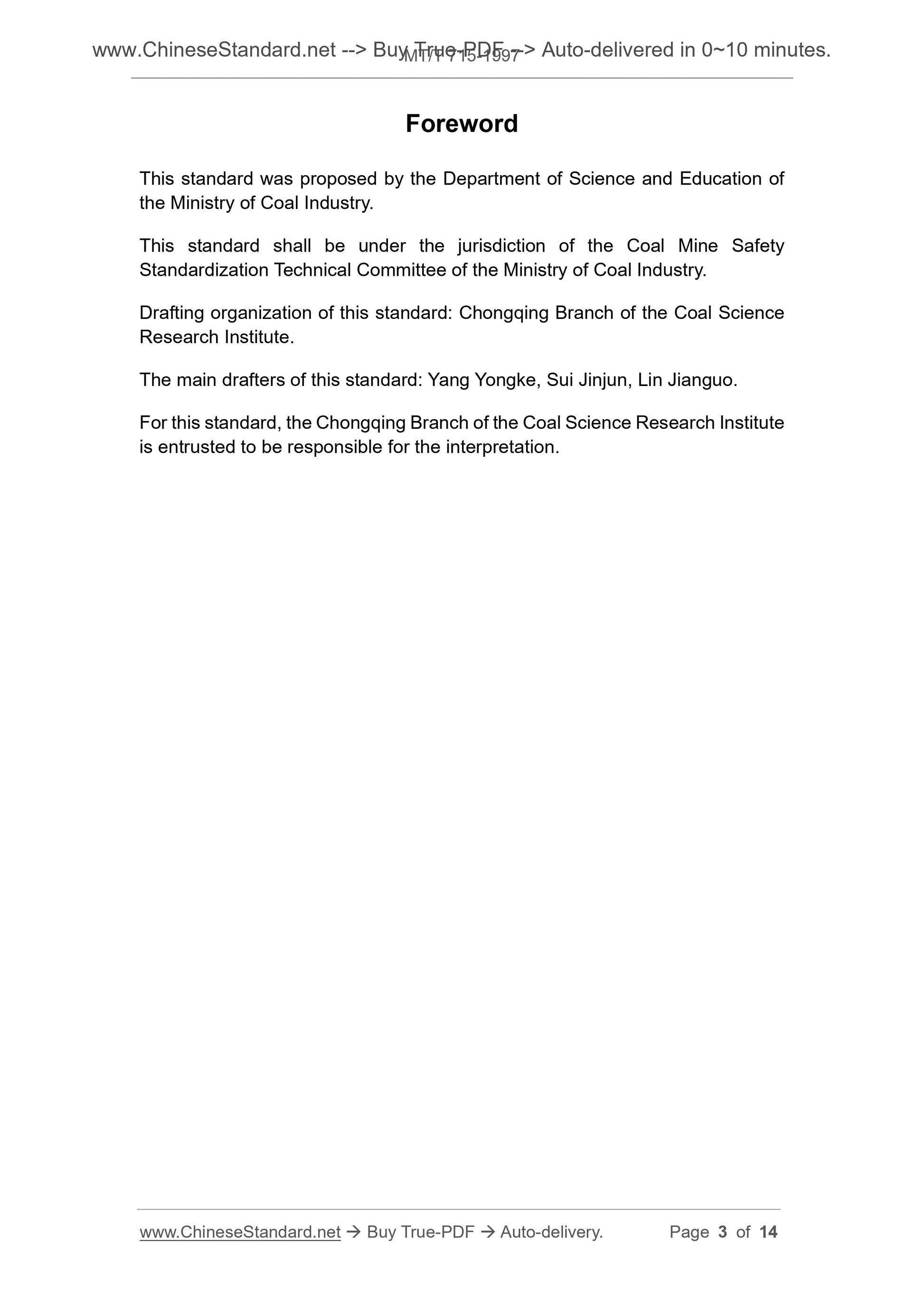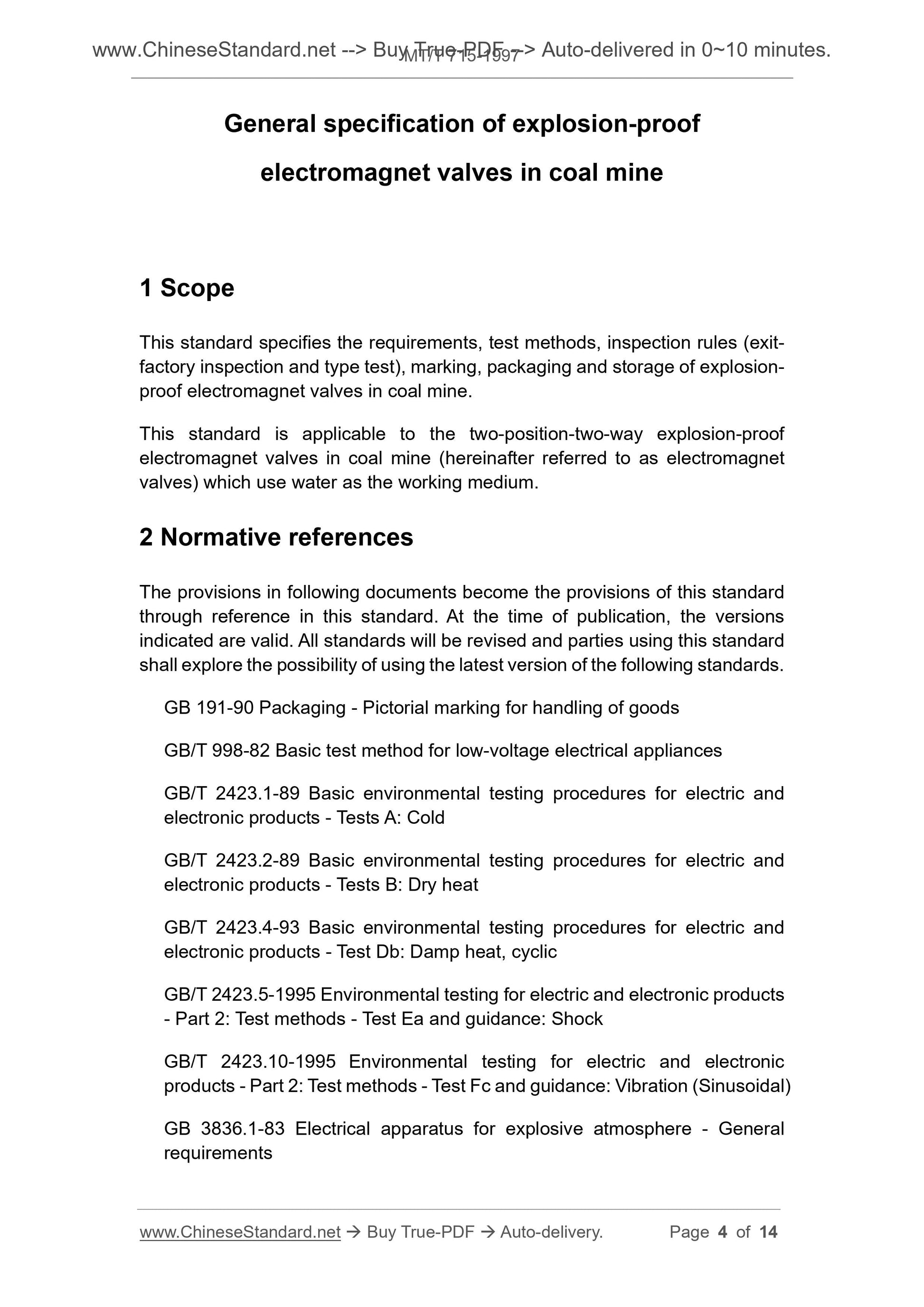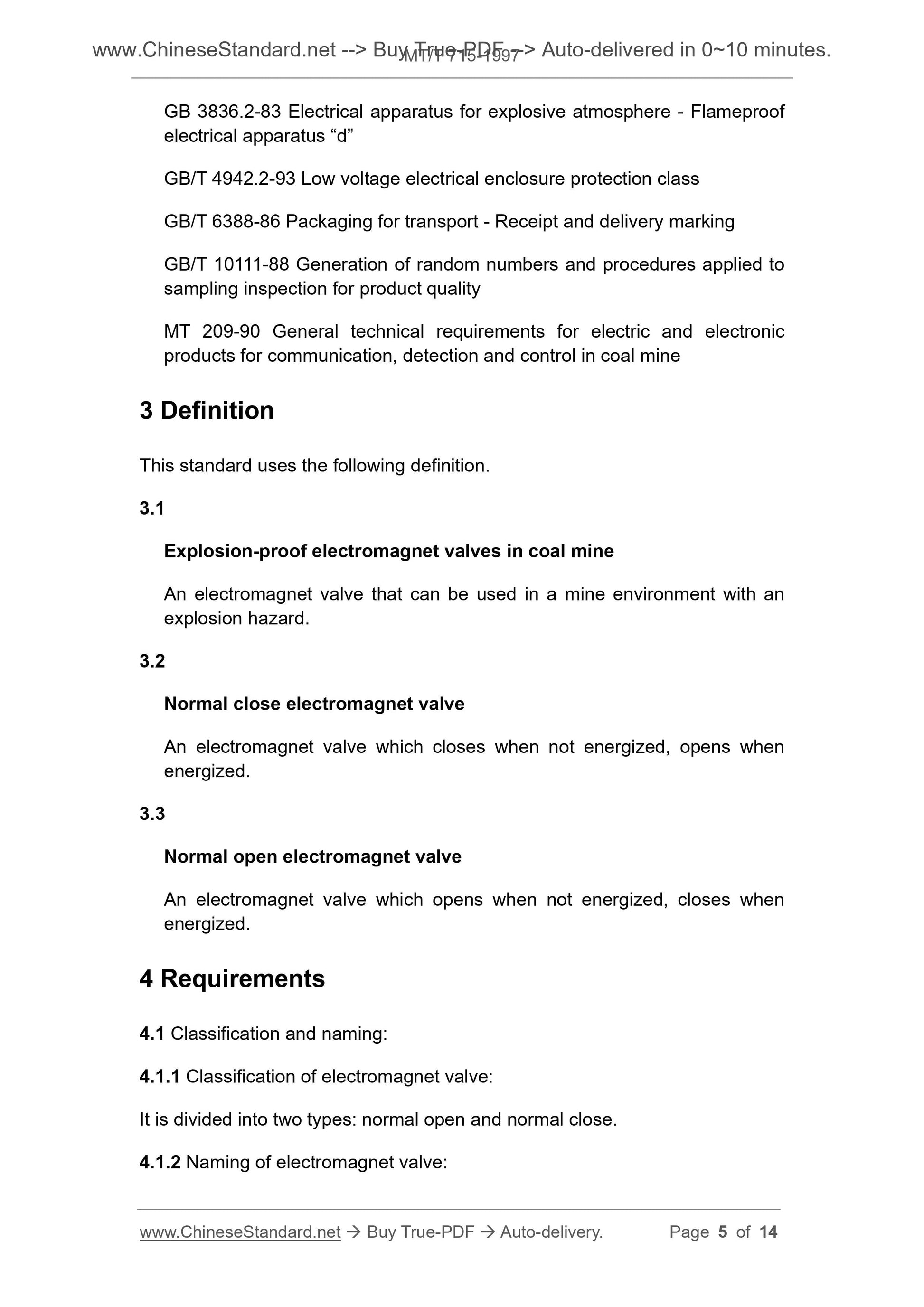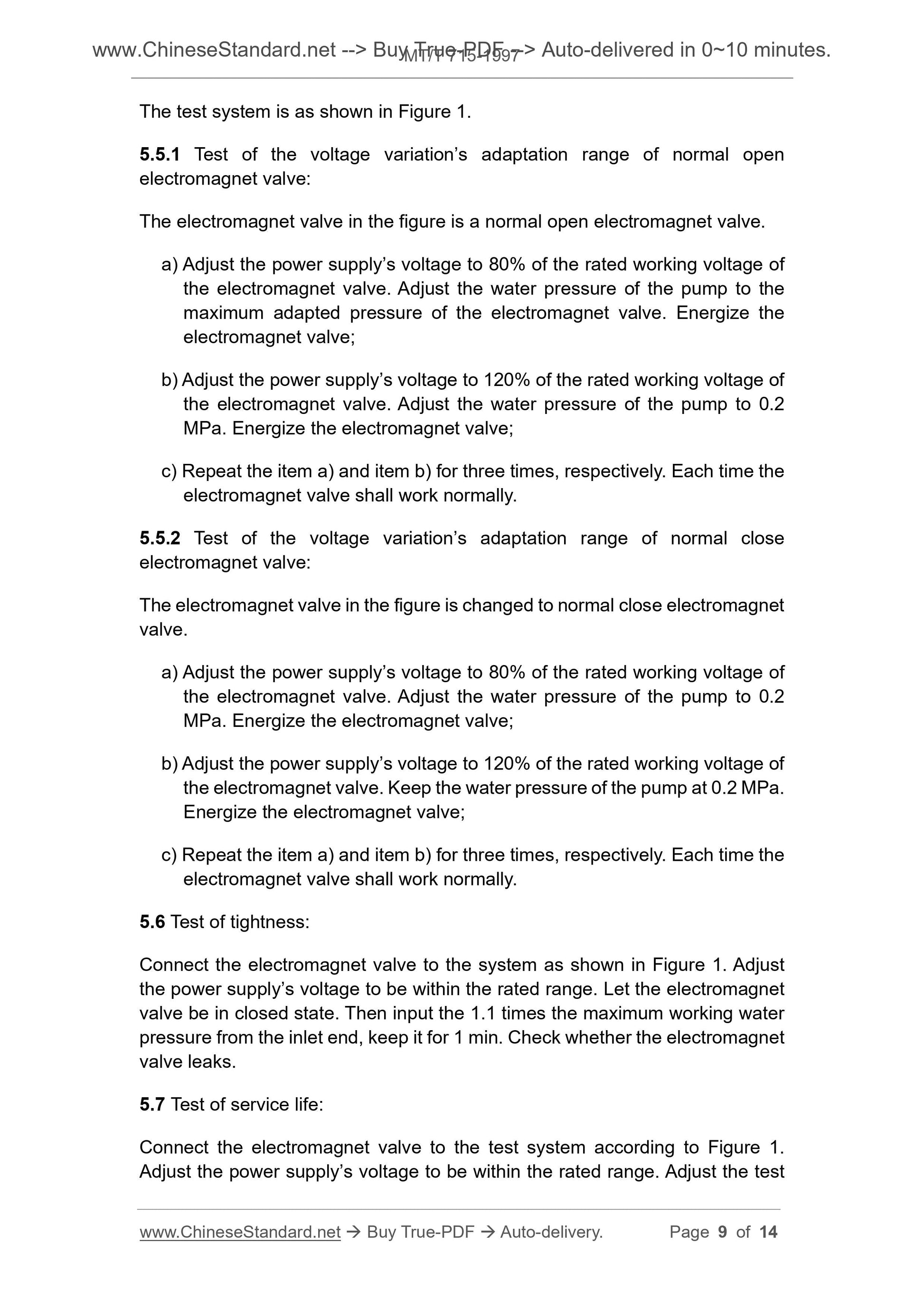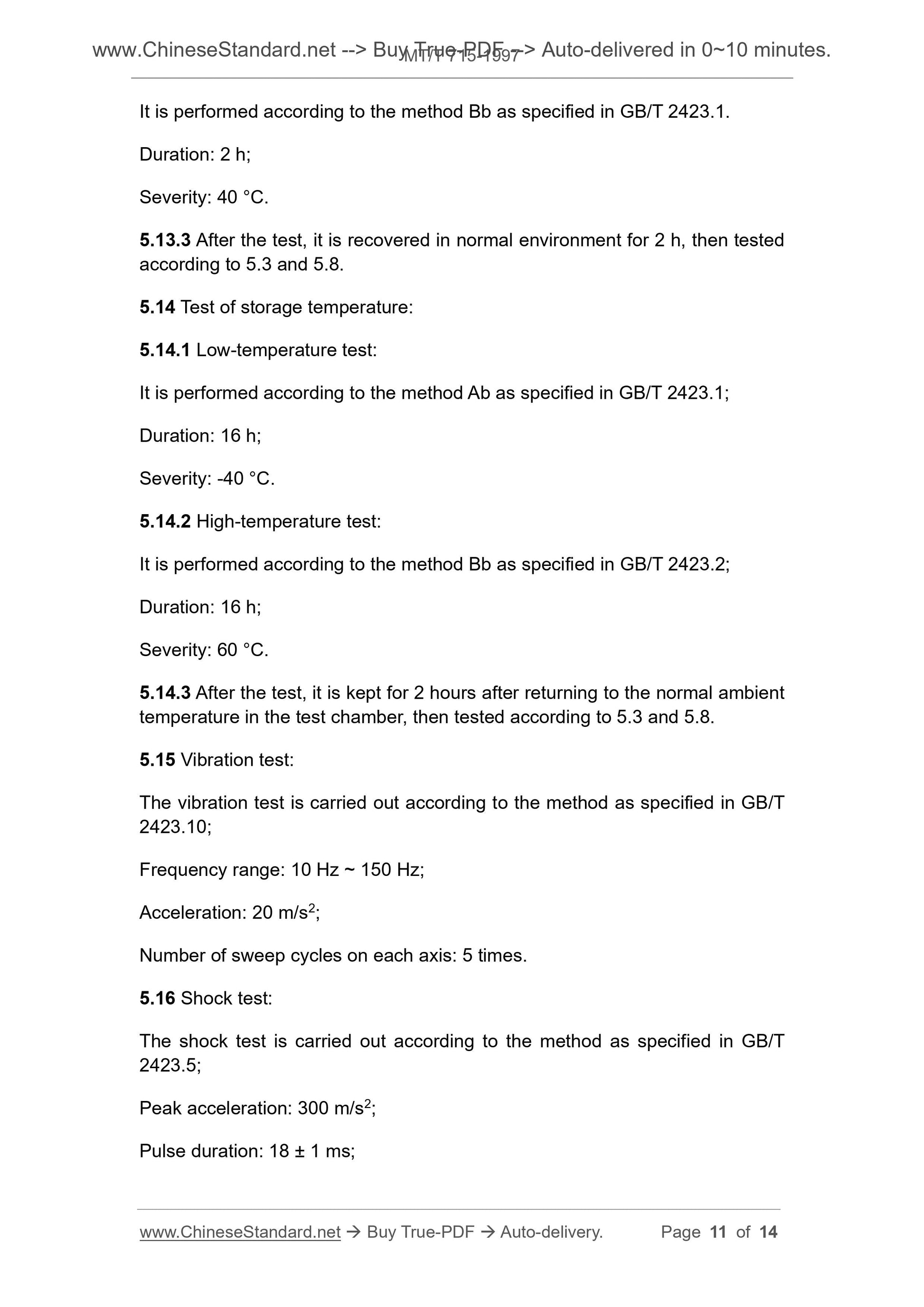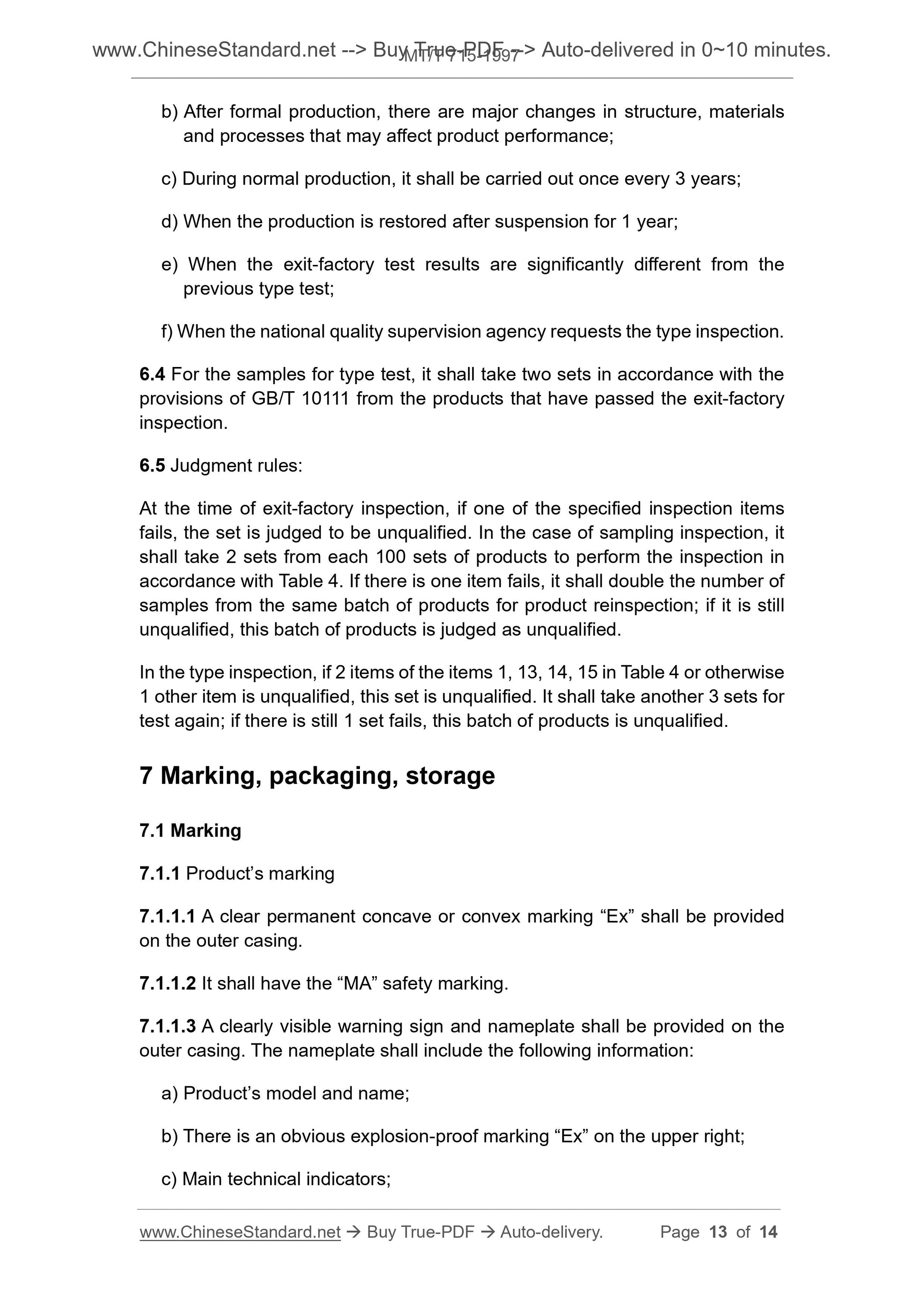1
/
of
8
PayPal, credit cards. Download editable-PDF & invoice in 1 second!
MT/T 715-1997 English PDF (MT/T715-1997)
MT/T 715-1997 English PDF (MT/T715-1997)
Regular price
$90.00 USD
Regular price
Sale price
$90.00 USD
Unit price
/
per
Shipping calculated at checkout.
Couldn't load pickup availability
Delivery: 3 seconds. Download true-PDF + Invoice.
Get QUOTATION in 1-minute: Click MT/T 715-1997
Historical versions: MT/T 715-1997
Preview True-PDF (Reload/Scroll if blank)
MT/T 715-1997: General specification of explosion-proof electromagnet valves in coal mine
MT/T 715-1997
MT
COAL INDUSTRY STANDARD OF
THE PEOPLE’S REPUBLIC OF CHINA
ICS 29.260.20
D 98
General specification of explosion-proof
electromagnet valves in coal mine
ISSUED ON. DECEMBER 30, 1997
IMPLEMENTED ON. JULY 01, 1998
Issued by. Ministry of Coal Industry of People’s Republic of China
Table of Contents
Foreword ... 3
1 Scope ... 4
2 Normative references ... 4
3 Definition ... 5
4 Requirements ... 5
5 Test methods ... 7
6 Inspection rules ... 12
7 Marking, packaging, storage ... 13
Foreword
This standard was proposed by the Department of Science and Education of
the Ministry of Coal Industry.
This standard shall be under the jurisdiction of the Coal Mine Safety
Standardization Technical Committee of the Ministry of Coal Industry.
Drafting organization of this standard. Chongqing Branch of the Coal Science
Research Institute.
The main drafters of this standard. Yang Yongke, Sui Jinjun, Lin Jianguo.
For this standard, the Chongqing Branch of the Coal Science Research Institute
is entrusted to be responsible for the interpretation.
General specification of explosion-proof
electromagnet valves in coal mine
1 Scope
This standard specifies the requirements, test methods, inspection rules (exit-
factory inspection and type test), marking, packaging and storage of explosion-
proof electromagnet valves in coal mine.
This standard is applicable to the two-position-two-way explosion-proof
electromagnet valves in coal mine (hereinafter referred to as electromagnet
valves) which use water as the working medium.
2 Normative references
The provisions in following documents become the provisions of this standard
through reference in this standard. At the time of publication, the versions
indicated are valid. All standards will be revised and parties using this standard
shall explore the possibility of using the latest version of the following standards.
GB 191-90 Packaging - Pictorial marking for handling of goods
GB/T 998-82 Basic test method for low-voltage electrical appliances
GB/T 2423.1-89 Basic environmental testing procedures for electric and
electronic products - Tests A. Cold
GB/T 2423.2-89 Basic environmental testing procedures for electric and
electronic products - Tests B. Dry heat
GB/T 2423.4-93 Basic environmental testing procedures for electric and
electronic products - Test Db. Damp heat, cyclic
GB/T 2423.5-1995 Environmental testing for electric and electronic products
- Part 2. Test methods - Test Ea and guidance. Shock
GB/T 2423.10-1995 Environmental testing for electric and electronic
products - Part 2. Test methods - Test Fc and guidance. Vibration (Sinusoidal)
GB 3836.1-83 Electrical apparatus for explosive atmosphere - General
requirements
GB 3836.2-83 Electrical apparatus for explosive atmosphere - Flameproof
electrical apparatus “d”
GB/T 4942.2-93 Low voltage electrical enclosure protection class
GB/T 6388-86 Packaging for transport - Receipt and delivery marking
GB/T 10111-88 Generation of random numbers and procedures applied to
sampling inspection for product quality
MT 209-90 General technical requirements for electric and electronic
products for communication, detection and control in coal mine
3 Definition
This standard uses the following definition.
3.1
Explosion-proof electromagnet valves in coal mine
An electromagnet valve that can be used in a mine environment with an
explosion hazard.
3.2
Normal close electromagnet valve
An electromagnet valve which closes when not energized, opens when
energized.
3.3
Normal open electromagnet valve
An electromagnet valve which opens when not energized, closes when
energized.
4 Requirements
4.1 Classification and naming.
4.1.1 Classification of electromagnet valve.
It is divided into two types. normal open and normal close.
4.1.2 Naming of electromagnet valve.
The test system is as shown in Figure 1.
5.5.1 Test of the voltage variation’s adaptation range of normal open
electromagnet valve.
The electromagnet valve in the figure is a normal open electromagnet valve.
a) Adjust the power supply’s voltage to 80% of the rated working voltage of
the electromagnet valve. Adjust the water pressure of the pump to the
maximum adapted pressure of the electromagnet valve. Energize the
electromagnet valve;
b) Adjust the power supply’s voltage to 120% of the rated working voltage of
the electromagnet valve. Adjust the water pressure of the pump to 0.2
MPa. Energize the electromagnet valve;
c) Repeat the item a) and item b) for three times, respectively. Each time the
electromagnet valve shall work normally.
5.5.2 Test of the voltage variation’s adaptation range of normal close
electromagnet valve.
The electromagnet valve in the figure is changed to normal close electromagnet
valve.
a) Adjust the power supply’s voltage to 80% of the rated working voltage of
the electromagnet valve. Adjust the water pressure of the pump to 0.2
MPa. Energize the electromagnet valve;
b) Adjust the power supply’s voltage to 120% of the rated working voltage of
the electromagnet valve. Keep the water pressure of the pump at 0.2 MPa.
Energize the electromagnet valve;
c) Repeat the item a) and item b) for three times, respectively. Each time the
electromagnet valve shall work normally.
5.6 Test of tightness.
Connect the electromagnet valve to the system as shown in Figure 1. Adjust
the power supply’s voltage to be within the rated range. Let the electromagnet
valve be in closed state. Then input the 1.1 times the maximum working water
pressure from the inlet end, keep it for 1 min. Check whether the electromagnet
valve leaks.
5.7 Test of service life.
Connect the electromagnet valve to the test system according to Figure 1.
Adjust the power supply’s voltage to be within the rated range. Adjust the test
It is performed according to the method Bb as specified in GB/T 2423.1.
Duration. 2 h;
Severity. 40 °C.
5.13.3 After the test, it is recovered in normal environment for 2 h, then tested
according to 5.3 and 5.8.
5.14 Test of storage temperature.
5.14.1 Low-temperature test.
It is performed according to the method Ab as specified in GB/T 2423.1;
Duration. 16 h;
Severity. -40 °C.
5.14.2 High-temperature test.
It is performed according to the method Bb as specified in GB/T 2423.2;
Duration. 16 h;
Severity. 60 °C.
5.14.3 After the test, it is kept for 2 hours after returning to the normal ambient
temperature in the test chamber, then tested according to 5.3 and 5.8.
5.15 Vibration test.
The vibration test is carried out according to the method as specified in GB/T
2423.10;
Frequency range. 10 Hz ~ 150 Hz;
Acceleration. 20 m/s2;
Number of sweep cycles on each axis. 5 times.
5.16 Shock test.
The shock test is carried out according to the method as specified in GB/T
2423.5;
Peak acceleration. 300 m/s2;
Pulse duration. 18 ± 1 ms;
b) After formal production, there are major changes in structure, materials
and processes that may affect product performance;
c) During normal production, it shall be carried out once every 3 years;
d) When the production is restored after suspension for 1 year;
e) When the exit-factory test results are significantly different from the
previous type test;
f) When the national quality supervision agency requests the type inspection.
6.4 For the samples ...
Get QUOTATION in 1-minute: Click MT/T 715-1997
Historical versions: MT/T 715-1997
Preview True-PDF (Reload/Scroll if blank)
MT/T 715-1997: General specification of explosion-proof electromagnet valves in coal mine
MT/T 715-1997
MT
COAL INDUSTRY STANDARD OF
THE PEOPLE’S REPUBLIC OF CHINA
ICS 29.260.20
D 98
General specification of explosion-proof
electromagnet valves in coal mine
ISSUED ON. DECEMBER 30, 1997
IMPLEMENTED ON. JULY 01, 1998
Issued by. Ministry of Coal Industry of People’s Republic of China
Table of Contents
Foreword ... 3
1 Scope ... 4
2 Normative references ... 4
3 Definition ... 5
4 Requirements ... 5
5 Test methods ... 7
6 Inspection rules ... 12
7 Marking, packaging, storage ... 13
Foreword
This standard was proposed by the Department of Science and Education of
the Ministry of Coal Industry.
This standard shall be under the jurisdiction of the Coal Mine Safety
Standardization Technical Committee of the Ministry of Coal Industry.
Drafting organization of this standard. Chongqing Branch of the Coal Science
Research Institute.
The main drafters of this standard. Yang Yongke, Sui Jinjun, Lin Jianguo.
For this standard, the Chongqing Branch of the Coal Science Research Institute
is entrusted to be responsible for the interpretation.
General specification of explosion-proof
electromagnet valves in coal mine
1 Scope
This standard specifies the requirements, test methods, inspection rules (exit-
factory inspection and type test), marking, packaging and storage of explosion-
proof electromagnet valves in coal mine.
This standard is applicable to the two-position-two-way explosion-proof
electromagnet valves in coal mine (hereinafter referred to as electromagnet
valves) which use water as the working medium.
2 Normative references
The provisions in following documents become the provisions of this standard
through reference in this standard. At the time of publication, the versions
indicated are valid. All standards will be revised and parties using this standard
shall explore the possibility of using the latest version of the following standards.
GB 191-90 Packaging - Pictorial marking for handling of goods
GB/T 998-82 Basic test method for low-voltage electrical appliances
GB/T 2423.1-89 Basic environmental testing procedures for electric and
electronic products - Tests A. Cold
GB/T 2423.2-89 Basic environmental testing procedures for electric and
electronic products - Tests B. Dry heat
GB/T 2423.4-93 Basic environmental testing procedures for electric and
electronic products - Test Db. Damp heat, cyclic
GB/T 2423.5-1995 Environmental testing for electric and electronic products
- Part 2. Test methods - Test Ea and guidance. Shock
GB/T 2423.10-1995 Environmental testing for electric and electronic
products - Part 2. Test methods - Test Fc and guidance. Vibration (Sinusoidal)
GB 3836.1-83 Electrical apparatus for explosive atmosphere - General
requirements
GB 3836.2-83 Electrical apparatus for explosive atmosphere - Flameproof
electrical apparatus “d”
GB/T 4942.2-93 Low voltage electrical enclosure protection class
GB/T 6388-86 Packaging for transport - Receipt and delivery marking
GB/T 10111-88 Generation of random numbers and procedures applied to
sampling inspection for product quality
MT 209-90 General technical requirements for electric and electronic
products for communication, detection and control in coal mine
3 Definition
This standard uses the following definition.
3.1
Explosion-proof electromagnet valves in coal mine
An electromagnet valve that can be used in a mine environment with an
explosion hazard.
3.2
Normal close electromagnet valve
An electromagnet valve which closes when not energized, opens when
energized.
3.3
Normal open electromagnet valve
An electromagnet valve which opens when not energized, closes when
energized.
4 Requirements
4.1 Classification and naming.
4.1.1 Classification of electromagnet valve.
It is divided into two types. normal open and normal close.
4.1.2 Naming of electromagnet valve.
The test system is as shown in Figure 1.
5.5.1 Test of the voltage variation’s adaptation range of normal open
electromagnet valve.
The electromagnet valve in the figure is a normal open electromagnet valve.
a) Adjust the power supply’s voltage to 80% of the rated working voltage of
the electromagnet valve. Adjust the water pressure of the pump to the
maximum adapted pressure of the electromagnet valve. Energize the
electromagnet valve;
b) Adjust the power supply’s voltage to 120% of the rated working voltage of
the electromagnet valve. Adjust the water pressure of the pump to 0.2
MPa. Energize the electromagnet valve;
c) Repeat the item a) and item b) for three times, respectively. Each time the
electromagnet valve shall work normally.
5.5.2 Test of the voltage variation’s adaptation range of normal close
electromagnet valve.
The electromagnet valve in the figure is changed to normal close electromagnet
valve.
a) Adjust the power supply’s voltage to 80% of the rated working voltage of
the electromagnet valve. Adjust the water pressure of the pump to 0.2
MPa. Energize the electromagnet valve;
b) Adjust the power supply’s voltage to 120% of the rated working voltage of
the electromagnet valve. Keep the water pressure of the pump at 0.2 MPa.
Energize the electromagnet valve;
c) Repeat the item a) and item b) for three times, respectively. Each time the
electromagnet valve shall work normally.
5.6 Test of tightness.
Connect the electromagnet valve to the system as shown in Figure 1. Adjust
the power supply’s voltage to be within the rated range. Let the electromagnet
valve be in closed state. Then input the 1.1 times the maximum working water
pressure from the inlet end, keep it for 1 min. Check whether the electromagnet
valve leaks.
5.7 Test of service life.
Connect the electromagnet valve to the test system according to Figure 1.
Adjust the power supply’s voltage to be within the rated range. Adjust the test
It is performed according to the method Bb as specified in GB/T 2423.1.
Duration. 2 h;
Severity. 40 °C.
5.13.3 After the test, it is recovered in normal environment for 2 h, then tested
according to 5.3 and 5.8.
5.14 Test of storage temperature.
5.14.1 Low-temperature test.
It is performed according to the method Ab as specified in GB/T 2423.1;
Duration. 16 h;
Severity. -40 °C.
5.14.2 High-temperature test.
It is performed according to the method Bb as specified in GB/T 2423.2;
Duration. 16 h;
Severity. 60 °C.
5.14.3 After the test, it is kept for 2 hours after returning to the normal ambient
temperature in the test chamber, then tested according to 5.3 and 5.8.
5.15 Vibration test.
The vibration test is carried out according to the method as specified in GB/T
2423.10;
Frequency range. 10 Hz ~ 150 Hz;
Acceleration. 20 m/s2;
Number of sweep cycles on each axis. 5 times.
5.16 Shock test.
The shock test is carried out according to the method as specified in GB/T
2423.5;
Peak acceleration. 300 m/s2;
Pulse duration. 18 ± 1 ms;
b) After formal production, there are major changes in structure, materials
and processes that may affect product performance;
c) During normal production, it shall be carried out once every 3 years;
d) When the production is restored after suspension for 1 year;
e) When the exit-factory test results are significantly different from the
previous type test;
f) When the national quality supervision agency requests the type inspection.
6.4 For the samples ...
Share
